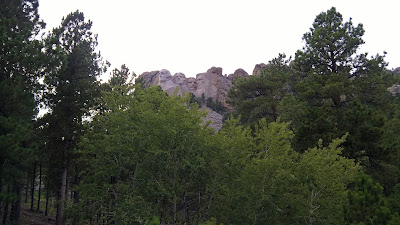
Native Americans consider the Black Hills to be sacred, so it was not without controversy that South Dakota historian Doane Robinson proposed carving "needles" rock formations into likenesses of famous people who shaped the west like Lewis and Clark, Buffalo Bill Cody and Red Cloud, as a means of attracting tourism to the region.
When architect Gutzon Borglum, who had already established a reputation for creating art of a scale worthy of the size and scope of the United States, noted the better quality of granite at Mount Rushmore made it a more suitable site than the needles, especially with its southeast orientation taking full advantage of day light.
Borglum also proposed a less regional theme, so as to make it easier to attain national funding for a project which would end up taking 14 years to carve (1927 through 1941).
Mount Rushmore National Memorial immortalizes four Presidents of the nation that overwhelmed and displaced the Lakota Sioux, Cheyenne, Appache and other Indian Nations.

The Father of Our Country, George Washington, led the colonies to their unlikely Revolutionary War victory against the greatest military in the world, and then he turned down the opportunity to become emperor, instead pushing for a democratically elected Presidency. He walked away of his own volition after two terms, setting the stage for America's historically unique heritage of peaceful transfer of power through elections. On the battlefield, Washington was considered "Magic" by native Americans, who saw bullets pass through him on the battlefield, proven by four clean holes through his battel jacket that hadn't shed his blood.
Another obvious choice was our 16th President, Abraham Lincoln, who led the United States through its greatest national challenge, the Civil War, and abolished slavery, fulfilling the promise of the Constitution which had accepted a distasteful compromise deemed necessary at the time to unite diverse colonies into a country large enough to be free of foreign countrol.
Before becoming our third President, Thomas Jefferson, wrote the Declaration of Independence, and if that wasn't enough as President he authorized $15 million for the Louisianna Purchase, which included South Dakota in its 828,000 acres.
Finally, Teddy Roosevelt, whose eye glasses are for me one of the most interesting features of the 60 foot faces memorialized. As I've frequently mentioned, TR vigorously pushed the preservation of our wonderful natural treasures for posterity.
At the visitor's center, there's a museum and also a wonderful short movie about how this massive sculpture was blasted out of the mountainside with dynamite and shaped with jackhammers and chisels by hard-working craftsmen.
It's amazing to consider this was all accomplished before the modern age of computer modeling and lasers. Borglum used an ancient technique called pointing, which was basically a measurement taken by a string with a plumb bob hanging from a boom. This measurement was repeated thousands of times on a model and then replicated 12 times larger on the mountain.
Actually, it was Gutzon Borglum's son Lincoln who actually oversaw most of the work on the project, including recruiting and supervising the workers. As a big baseball fan, Lincoln Borglum hired good ballplayers, so that he could field a winning Mount Rushmore team. His men worked well together as a team not only on the ballfield but on the massive mountain project, and remarkably, not a single man lost his life during the dangerous fourteen years of blasting and jackhammering at towering heights.
Mount Rushmore successfully lures three million visitors a year to South Dakota, as Doane Robinson envisioned, and once you're there, you will undoubtedly see for yourself how gorgeous the Black Hills are, as he envisioned. There's no admission to the memorial, but parking costs $11 per car.




No comments:
Post a Comment